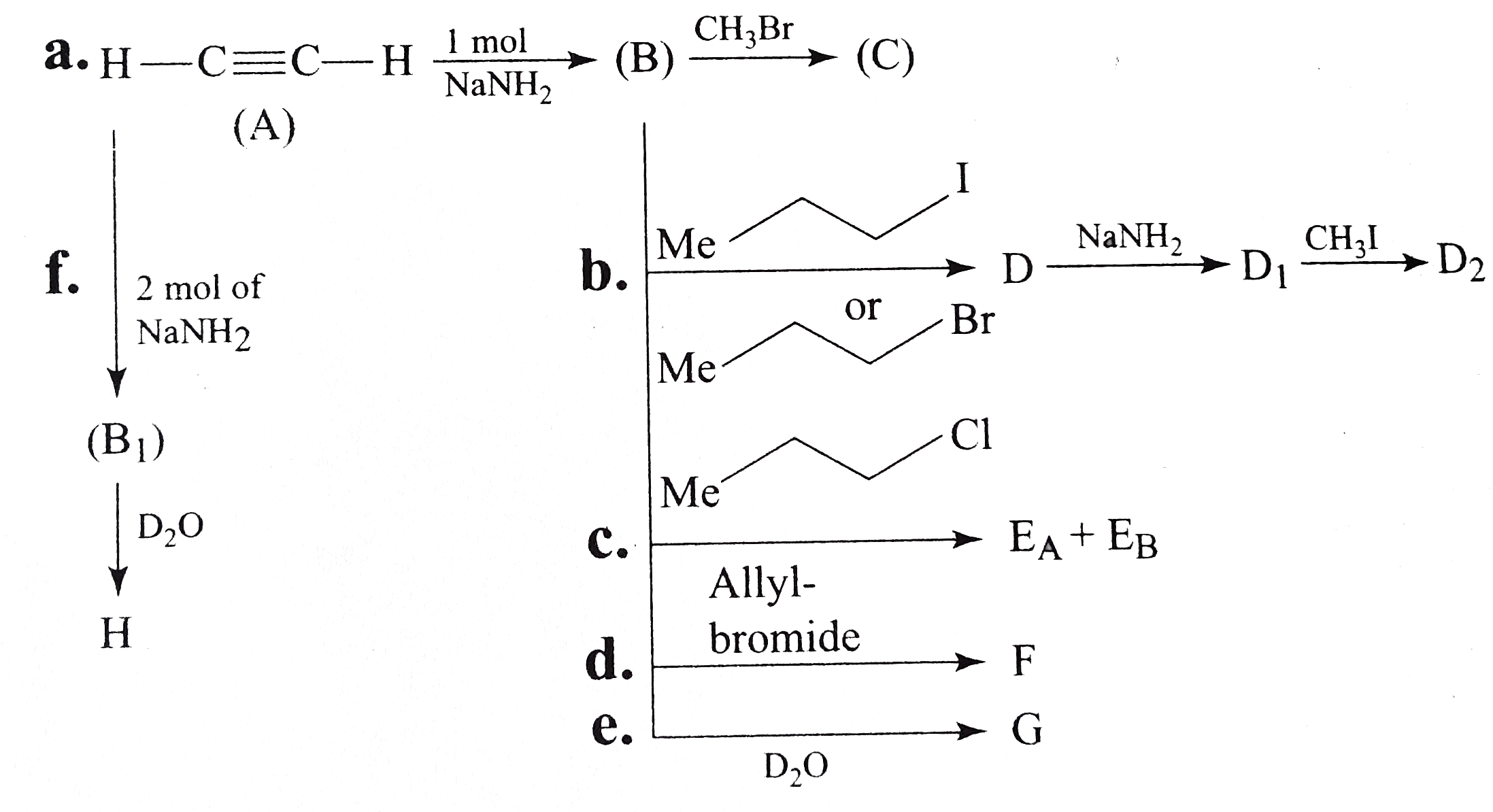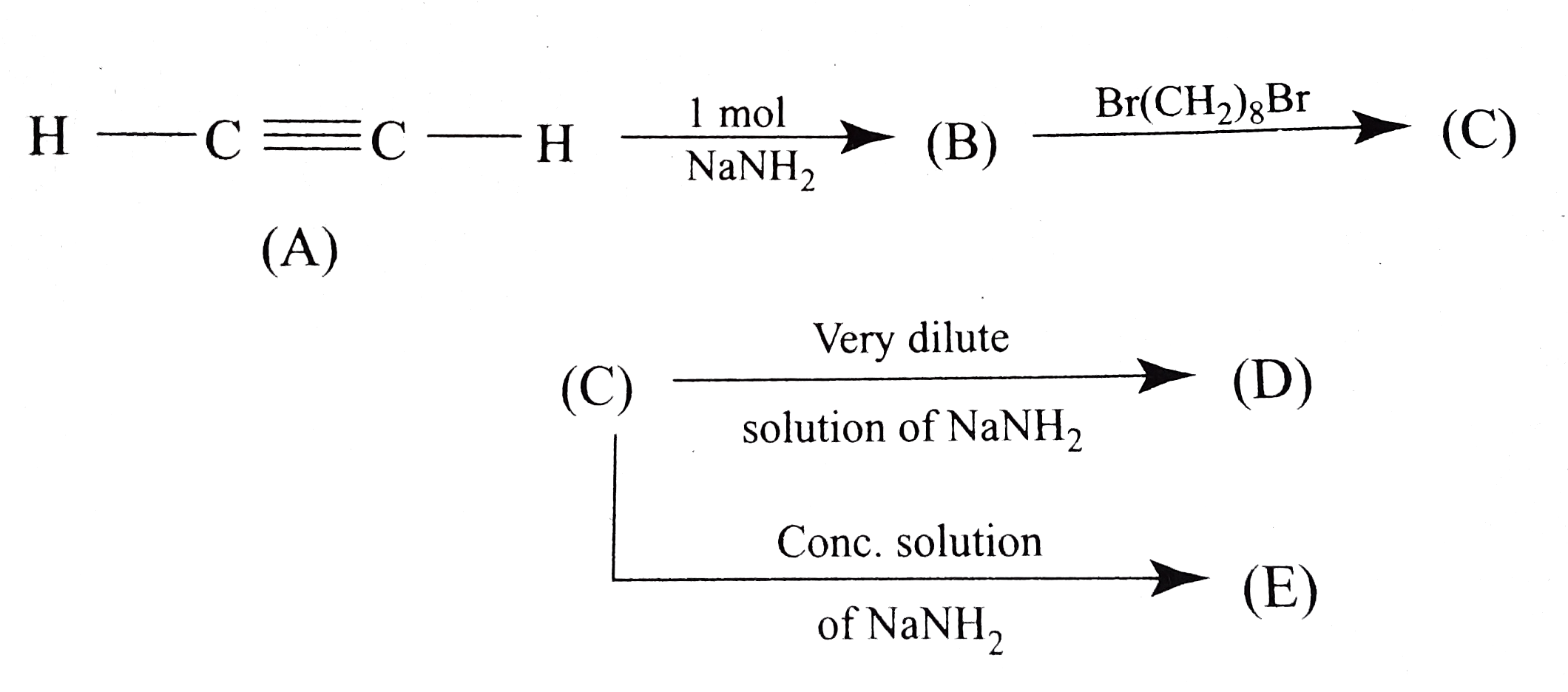In the following sequence of reactions, the products (A) to (G) are formed:
i. 2CH4(g)Δ−−−→1773K(A)(g)+B(g)
ii. 4molof(A)Δ−−−−−−−−−−→Ni(CN)4+THF(C)O3/oxid.−−−−−→(D)only
iii. (A)(1)1molofNaNH2−−−−−−−−−−−→(2)C2H5I(E)3molofE−−−−−−→RedhottubeF⏐↓O3/Red.(G)only
Compound D is:
Glyoxal
Glycol
Oxalic acid
Methylglyoxal
The correct Answer is:C
To solve the problem step by step, we need to analyze each reaction and identify the compounds formed from the given reactions.
Step 1: Identify Compound A
The first reaction is:
2CH4(g)Δ⟶(A)(g)+B(g)
When methane (CH4) is heated, it undergoes dehydrogenation to form acetylene (C2H2) and hydrogen gas (H2). Therefore, compound A is:
A=C2H2
Step 2: Identify Compound C
The second reaction is:
4 mol of (A)Δ⟶Ni(CN)4+THF(C)
When 4 moles of acetylene (C2H2) are treated with nickel in THF, cyclization occurs, leading to the formation of a cyclic compound. The product of this reaction is likely to be a cyclobutene (C4H6) or a similar cyclic structure. Thus, we can denote:
C=C4H6
Step 3: Identify Compound D
The next part of the reaction is:
CO3//oxid.⟶(D)
Ozonolysis of cyclobutene will cleave the double bonds, leading to the formation of two molecules of carbonyl compounds. In this case, the ozonolysis of cyclobutene can yield oxalic acid (C2H2O4). Therefore, we can conclude:
D=C2H2O4
Step 4: Identify Compound E
The next reaction is:
(A)(1)1 mol of NaNH2⟶(2)C2H5I(E)
Here, sodium amide (NaNH2) acts as a strong base and deprotonates acetylene to form sodium acetylide, which then reacts with ethyl iodide (C2H5I) to form butyne (C4H6). Thus:
E=C4H6
Step 5: Identify Compound G
The final reaction is:
(3 mol of E)Red hot tube⟶(G) only(F)
When butyne is heated in a red hot tube, it can undergo further reactions, possibly leading to the formation of smaller hydrocarbons or even carbon monoxide and hydrogen. However, the exact product is less relevant for identifying D.
Conclusion
The compound D formed in the sequence of reactions is:
D=C2H2O4 (Oxalic Acid)
The first reaction is:
2CH4(g)Δ⟶(A)(g)+B(g)
When methane (CH4) is heated, it undergoes dehydrogenation to form acetylene (C2H2) and hydrogen gas (H2). Therefore, compound A is:
A=C2H2
The second reaction is:
4 mol of (A)Δ⟶Ni(CN)4+THF(C)
When 4 moles of acetylene (C2H2) are treated with nickel in THF, cyclization occurs, leading to the formation of a cyclic compound. The product of this reaction is likely to be a cyclobutene (C4H6) or a similar cyclic structure. Thus, we can denote:
C=C4H6
The next part of the reaction is:
CO3//oxid.⟶(D)
Ozonolysis of cyclobutene will cleave the double bonds, leading to the formation of two molecules of carbonyl compounds. In this case, the ozonolysis of cyclobutene can yield oxalic acid (C2H2O4). Therefore, we can conclude:
D=C2H2O4
The next reaction is:
(A)(1)1 mol of NaNH2⟶(2)C2H5I(E)
Here, sodium amide (NaNH2) acts as a strong base and deprotonates acetylene to form sodium acetylide, which then reacts with ethyl iodide (C2H5I) to form butyne (C4H6). Thus:
E=C4H6
The final reaction is:
(3 mol of E)Red hot tube⟶(G) only(F)
When butyne is heated in a red hot tube, it can undergo further reactions, possibly leading to the formation of smaller hydrocarbons or even carbon monoxide and hydrogen. However, the exact product is less relevant for identifying D.
The compound D formed in the sequence of reactions is:
D=C2H2O4 (Oxalic Acid)
Topper's Solved these Questions
- ALKYNESBOOK - CENGAGE CHEMISTRY ENGLISHCHAPTER - ALKYNESEXERCISE - Exercises (Multiple Correct Answers Type)
25 Videos
- ALKYNESBOOK - CENGAGE CHEMISTRY ENGLISHCHAPTER - ALKYNESEXERCISE - Exercises (Single Correct Answers Type)
30 Videos
- ALKYNESBOOK - CENGAGE CHEMISTRY ENGLISHCHAPTER - ALKYNESEXERCISE - Exercises (Subjective Type)
31 Videos
- ALKENES AND ALKADIENESBOOK - CENGAGE CHEMISTRY ENGLISHCHAPTER - ALKENES AND ALKADIENESEXERCISE - Single correct Answer
14 Videos
- APPENDIX - INORGANIC VOLUME 1BOOK - CENGAGE CHEMISTRY ENGLISHCHAPTER - APPENDIX - INORGANIC VOLUME 1EXERCISE - chapter-7 Single correct answer
1 Videos
Similar Questions
In the following sequence of reactions, the products (A) to (G) are formed:
i. 2CH4(g)Δ−−−→1773K(A)(g)+B(g)
ii. 4molof(A)Δ−−−−−−−−−−→Ni(CN)4+THF(C)O3/oxid.−−−−−→(D)only
iii. (A)(1)1molofNaNH2−−−−−−−−−−−→(2)C2H5I(E)3molofE−−−−−−→RedhottubeF⏐↓O3/Red.(G)only
Compounds G is
View SolutionIn the following sequence of reactions, the products (A) to (G) are formed:
i. 2CH4(g)Δ−−−→1773K(A)(g)+B(g)
ii. 4molof(A)Δ−−−−−−−−−−→Ni(CN)4+THF(C)O3/oxid.−−−−−→(D)only
iii. (A)(1)1molofNaNH2−−−−−−−−−−−→(2)C2H5I(E)3molofE−−−−−−→RedhottubeF⏐↓O3/Red.(G)only
Compounds (A) and (B), respectively, are:
View Solution
Knowledge Check
H3C−CH3∣C∣CH3−H+CCl4R2O2−−→hvProduct :
AH3C−CH3∣C∣CH3−ClBCHCl3CBoth (a) and (b)DNone of these Br2−−→CCl4(i)alc. KOH−−−−−−−→(ii)NaNH2(A)major, Product (A) is :AH2C=CH−CH=CH2BCH3−C≡C−CH3CCH3−CH2−C≡CHDCH3−CH=C=CH2
Br2−−→CCl4(i)alc. KOH−−−−−−−→(ii)NaNH2(A)major, Product (A) is :AH2C=CH−CH=CH2BCH3−C≡C−CH3CCH3−CH2−C≡CHDCH3−CH=C=CH2
In the following sequence of reaction, the product C is
CH3−BrKCN−−→AH2O+−−−→BLiAlH4−−−→EtherC
View Solution (B)2mol−−−−−−→Cl2+hv (C)2mol−−−−−−−−→Alc.KOH
(B)2mol−−−−−−→Cl2+hv (C)2mol−−−−−−−−→Alc.KOH
(D) CH2=CH2−−−−−−−→Δ (E)
The final product (E) is :
View SolutionConsider the following sequence of reactions
C2H5C≡CHCH3MgBr−−−−−→A(1)HCHO−−−−−−→(2)H2O+B
The product (B) is
View SolutionIn the following reaction sequence Y is,
PhOCOCH3AlCl3−−→Δ(X)I2−−−→NaOH(Y)
View Solution(CH3)2CONaCN−−−→HCI(A)H+3O−−→Δ(B)
In the above sequence of reactions, (A) and (B) are :
View SolutionComplete the following reactions: a. H−C(A)≡C−H1mol−−−−→NaNH2(B)CH3Br−−−→(C)

g. H−C≡C(A)−H1mol−−−−→NaNH2(B)Br(CH2)8Br−−−−−−−−→(C)

View Solution
